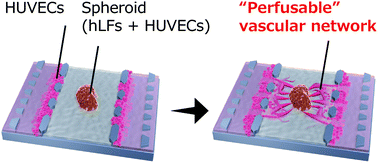Integrating perfusable vascular networks with a three-dimensional tissue in a microfluidic device†
Abstract
Creating vascular networks in tissues is crucial for tissue engineering. Although recent studies have demonstrated the formation of vessel-like structures in a tissue model, long-term culture is still challenging due to the lack of active perfusion in vascular networks. Here, we present a method to create a three-dimensional cellular spheroid with a perfusable vascular network in a microfluidic device. By the definition of the cellular interaction between human lung fibroblasts (hLFs) in a spheroid and human umbilical vein endothelial cells (HUVECs) in microchannels, angiogenic sprouts were induced from microchannels toward the spheroid; the sprouts reached the vessel-like structures in a spheroid to form a continuous lumen. We demonstrated that the vascular network could administer biological substances to the interior of the spheroid. As cell density in the spheroid is similar to that of a tissue, the perfusable vasculature model opens up new possibilities for a long-term tissue culture in vitro.

- This article is part of the themed collection: Integrative Biology Most Downloaded Articles


 Please wait while we load your content...
Please wait while we load your content...